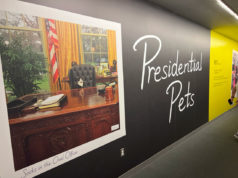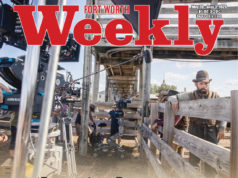If Byrd Williams IV were not a world-class photographer, he might be doing just about as well as a writer.
As editor of Fort Worth Weekly, I’ve known for years about Byrd’s photographic skills and the legacy of his family of photographers going back three generations before him. Byrd agreed, first, to allow the Weekly to run a photo essay back in 2009 that gave readers just a tantalizing taste of his and his father’s and grandfather’s and great-grandfather’s photographic vision. We called it “Byrds’ Eye View,” which I thought to be quite clever but have figured out since then is an oft-used caption for the family’s work.
After that, Byrd took on several other assignments for the Weekly. He has a real love for photographing things that our larger society hides or pretends not to see — the subculture of folks who populate the infields and stands of NASCAR races, drag queens, the culture of violence that is so strong in Texas. For an alternative newspaper that seeks to shine a light on the news and people that otherwise get ignored, you could say that Byrd was right up our alley. It’s not often someone whose work is in multiple museums will work for what the Weekly pays.
But I didn’t know until a couple of weeks ago what a writer Byrd is. In February, the University of North Texas announced that it had completed negotiations to acquire his vast family collection, including prints, cameras, journals, and much more, dating back almost 120 years (“UNT Acquires Williams Collection,” Feb. 28, 2014). I thought it was some of the best cultural news for North Texas in a while, since I knew that, for a long time, it looked like there might be no deal made to keep the collection in this area, especially since it includes many thousands of very fragile negatives and plates that will require careful work to conserve.
Last month, UNT invited Byrd to give the annual Voertman Lecture for the Friends of the UNT Libraries. I went as one of his guests, expecting to applaud him, his work, and UNT’s acquisition of the collection.
I didn’t expect to hear a fascinating meditation on history, consciousness, and the transmission of culture. He began with a quote from British novelist Ian McEwan about how “We are the very privileged owners of a brief spark of consciousness, and we therefore have to take responsibility for it.”
“All of us,” Byrd said, “are trying to nail down that spark while we’re here.”
He and his family have been trying to capture that spark for more than a century. Byrd IV himself started taking pictures when he was six or seven. “For my 10th birthday I got a gun and a camera,” he said. “Thank goodness I went toward the camera.”
For many years — he calls them “the prison years” — he worked in his family’s photo business, which involved not only photographing little girls in dancing classes but also engineering projects, crime, the Kennedy assassination, and much more. His family had one of the first color labs in Texas and did color developing for customers all over the state.
“To get through history to the future, you had to come through the camera,” he told the audience. “You had to come through me,” he said. “If you got married and there were no pictures … did it really happen?”
I was less surprised but no less entertained to also hear about Byrd’s self-described “line of baloney” for getting people to let him take their pictures or let him into their bathrooms to take pictures, about his gig with televangelists, the relative lifespans of silver and gold (in photographic plates), how the stuff that Europeans carry in their pockets is more interesting than what Americans carry, and how his granddad’s drinking sessions with Pancho Villa earned Byrd IV better treatment from author Larry McMurtry.
There was much more. Byrd explained that, because his family collection is so huge — including more than 300,000 negatives — he really has no idea of everything that it contains. (Although he does know that, to use one of the cameras in the collection, he must now check it out from the UNT Libraries just like any other student or researcher.)
Byrd’s wealth of stories and insights seems almost as intriguing as the collection.
The Williams collection is one of the UNT Libraries’ most massive, clearly a treasure trove that scholars will be delving into for many years.
Because the deal for the collection includes a book, perhaps many of Byrd’s stories and thoughts on all of it will be preserved there. University of Texas-Austin senior curator Roy Flukinger will write it.
Byrd, meanwhile, is still teaching, as a professor at Collin College and still taking pictures. For a long time he thought of himself as an artist, he said, but now he’s back to thinking of himself as a photographer, documenting our world or, more correctly, our worlds, from German cityscapes to the fraternity of people who have been shot and lived to tell about it, to his continuing project to photograph Fort Worth landmarks, including many taken from rooftops.
As with so many other subjects, Byrd doesn’t seek permission. He just takes the elevator to the top floor and figures out from there how to get onto the roof. Asking permission, he said, “just takes time.”
He’s not going to stop, he said. “I’m going to keep doing it. I’m going to climb on every roof.”












